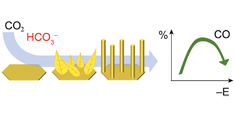Publication
885
ACS Central Science 5 (3),1097-1105, 2019
DOI:10.1021/acscentsci.9b003028
|
|
|
|
|
|

|
Interplay of Homogeneous Reactions, Mass Transport, and Kinetics in Determining Selectivity of the Reduction of CO2 on Gold Electrodes
|
|
|
|
Benjamin A. Zhang, Tuncay Ozel, Joseph S. Elias, Cyrille Costentin, and Daniel G. Nocera
Department of Chemistry and Chemical Biology, Harvard University, 12 Oxford Street, Cambridge, Massachusetts 02138, United States
Laboratoire d’Electrochimie Moléculaire, Unité Mixte de Recherche Université − CNRS No. 7591, Bâtiment Lavoisier, Université Paris Diderot, Sorbonne Paris Cité, 15 rue Jean de Baïf, 75205 Paris Cedex 13, France
Gold electrocatalysts have been a research focus due to their ability to reduce CO2 into CO, a feedstock for further conversion. Many methods have been employed to modulate CO2 reduction (CDR) vs hydrogen evolution reaction (HER) selectivity on gold electrodes such as nano-/mesostructuring and crystal faceting control. Herein we show that gold surfaces with very different morphologies (planar, leaves, and wires) lead to similar bell-shaped CO faradaic efficiency as a function of applied potential. At low overpotential (E > -0.85 V vs standard hydrogen electrode (SHE)), HER is dominant via a potential quasi-independent rate that we attribute to a rate limiting process of surface dissociation of competent proton donors. As overpotential is increased, CO faradaic efficiency reaches a maximal value (near 90%) because CO production is controlled by an electron transfer rate that increases with potential, whereas HER remains almost potential independent. At high overpotential (E < -1.2 V vs SHE), CO faradaic efficiency decreases due to the concurrent rise of HER via bicarbonate direct reduction and leveling off of CDR as CO2 replenishment at the catalyst surface is limited by mass transport and homogeneous coupled reactions. Importantly, the analysis shows that recent attempts to overcome mass transport limitations with gas diffusion electrodes confront low carbon mass balance owing to the prominence of homogeneous reactions coupled to CDR. The comprehensive kinetics analysis of the factors defining CDR vs HER on gold electrodes developed here provides an activation-driving force relationship over a large potential window and informs on the design of conditions to achieve desirable high current densities for CO2 to CO conversion while maintaining high selectivity. |

